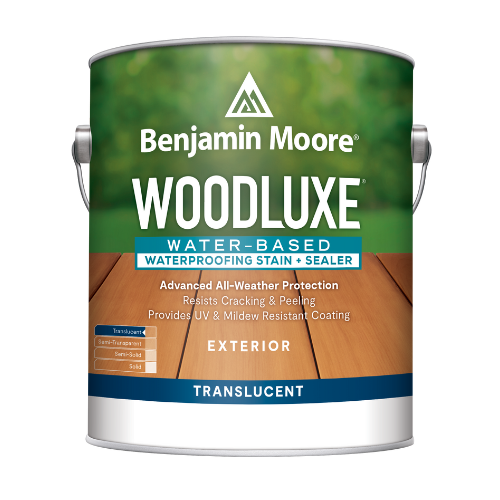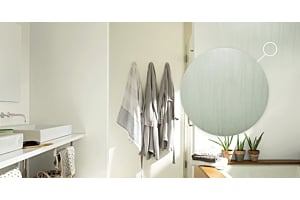
Time to give your well-loved patio furniture, porch swing, or picnic bench a new look? In this step-by-step guide, we’ll walk through how to stain outdoor furniture pieces — with tips from our pros on how to get a professional finish you’ll be proud of.
Step #1: Set Up Your Workspace
Choose a well-ventilated area to work, like a garage with the door open or an outdoor space, and lay drop cloths.
Good ventilation is important for dispersing fumes and for letting the stain dry evenly. However, it's important not to leave the furniture outside to dry. Exposure to direct sunlight, wind, or sudden changes in weather can cause the stain to dry unevenly or lead to dust and debris sticking to the wet surface.
This is also a good time to double check that the wood is fully dry. Too much moisture will interfere with the stain. Make sure the furniture hasn’t been rained on recently or otherwise exposed to significant moisture in the last 24-48 hours. The wood must not exceed 15% moisture content for proper stain penetration.
Outdoor Furniture Stain Supply List
- Drop cloths
- Homemade cleaning solution or wood cleaner
- Scrub brush
- Finish remover (if needed)
- Synthetic brush (for a water-based stain)
- Natural-bristle brush (for an oil stain)
- 80-grit sandpaper
- 120-grit sandpaper
- Tack cloth
- Exterior wood stain
Step #2: Clean the Furniture
If the furniture has mold and mildew stains or hardened grime, pressure wash it with an exterior wood cleaning solution like Woodluxe All-in-One Wood Cleaner. If it only needs a mild cleaning to remove dirt, you can create a homemade solution with water and dish detergent.
Make sure you thoroughly rinse the furniture after applying the cleaning solution — and let the wood fully dry before you apply the stain!
Was the furniture painted or stained before?
If so, you’ll need to remove the previous finish by sanding it down and/or applying a finish remover like Woodluxe Remover. Allow the solution to stand for the recommended amount of time and rinse it thoroughly. Note that you don’t have to strip the old finish if it’s a stain (that isn’t peeling) and the new stain isn’t more transparent than the old stain.
Step #3: Sand the Wood Surface
Next you’ll need to sand the furniture to create a smooth, even surface for the stain to sink into. An orbital sander works well for this stage. Be sure to sand with the grain, and remove dust from the surface with a tack cloth.
If the furniture has a previous coating: Start with coarse 80-grit sandpaper to remove the top layer and open up the wood. The stain won’t sink into a sealed surface. A simple test for this is to splash some water on the surface — if it absorbs into the wood, you are ready to stain, but if it beads up, you need to sand further. End with 120-220-grit sandpaper to create a smooth finish.
If working with raw wood or using a stain remover: Start with 120-150 grit sandpaper and end with 220-grit sandpaper.
Step #4: Apply a High-Quality Exterior Wood Stain
Apply a single, uniform coat of your stain* — working with the wood grain and always maintaining a wet edge. Be careful not to over-apply the stain and don’t apply more than one coat. Multiple coats, or a coat that’s too heavy, will interfere with the stain’s look and its ability to protect the wood. If you accidentally over apply the stain, soak up the puddles with a rag to avoid creating shiny spots.
Apply a water-based stain using a 100% Polyester Bristle Brush. For oil-based stains use a 100% Pure White China Bristle Brush.
*Make sure the stain is rated for outdoor use! Interior and exterior wood stains are very different products, and an interior stain will not protect outdoor wood furniture from the elements.
Why We Recommend Water-Based Stains
We recommend applying a premium, water-based stain like Benjamin Moore Woodluxe on outdoor wood furniture made from softwoods (such as cedar, pine, or redwood).
This is for a few reasons...
- Water-based stains clean up easily with soap and water, while paint thinner is required to clean oil-based stains out of your tools and workspace
- Water-based stains dry much faster than oil stains
- Water-based stains are safer and more environmentally friendly, with lower levels of VOCs (volatile organic compounds) than oil stains
The exception is if you’re staining hardwoods (such as oak, cherry, or teak). In that case, we would recommend using an oil finish.

Benjamin Moore Woodluxe Stains
Grade: Premium
Formula: Water-based (oil also available)
Opacities: Translucent, Semi-Transparent, Semi-Solid, Solid
prefer and the level of protection the furniture needs. Translucent stains reveal the natural beauty of the wood, while a solid color stain provides better durability — creating a paint-like coating that offers superior protection from UV rays and weathering.
Remember to test samples on a scrap piece of wood before committing to a color and opacity!
Find Premium Outdoor Wood Stains at Ring’s End
Ring’s End is proud to supply our customers with the highest quality products that make projects simple and successful. Explore premium exterior wood stains at Ring’s End both in-store and online. As an authorized Benjamin Moore retailer, we ship Benjamin Moore Woodluxe samples and products anywhere in the U.S.!
If you have any questions about staining exterior wood — or Woodluxe products — let us know and we’ll be happy to help. You can visit our paint and stain experts in-store, chat with our team online, or text us directly at (203) PRO-HELP.





